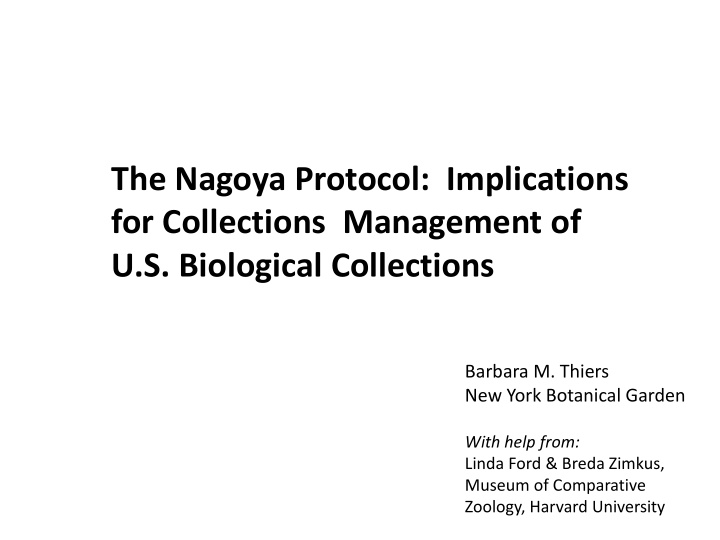



The Nagoya Protocol: Implications for Collections Management of U.S. Biological Collections Barbara M. Thiers New York Botanical Garden With help from: Linda Ford & Breda Zimkus, Museum of Comparative Zoology, Harvard University
A New Landscape for International Research • Nagoya Protocol on Access and Benefit- Sharing (ABS) - Legally binding supplementary agreement to the Convention on Biological Diversity - Outlines obligations for genetic resources and associated traditional knowledge (ABCs of ABS): Access regulated o Benefits from utilization shared o Compliance measures required o Even non-signatory countries must comply with domestic ABS legislation!
ABS Application • Applies to genetic resources acquired from a Party as of 12 Oct 2014 or later (when country became Party and established ABS measures) • Some countries use an earlier date because they established access legislation before Nagoya Protocol • Anything that contains or once contained DNA is a genetic resource
Blue: Signed, ratified Green: Signed, not yet ratified Dark gray: non- signatory, but CBD party Light gray: non- signatory, non CBD Even non-signatory countries must comply with domestic ABS legislation! – Requires creation of legal documentation about collections – Requires maintaining all legal documentation for each specimen throughout its entire research life – Requires tracking all activities and transactions from the point of specimen collection and in perpetuity
Steps Required for ABS Compliance I. Collections Acquisition • Partner institution in host country and U.S. institution sign governing documents (Prior Informed Consent (PIC) and Mutually Agreed Terms (MAT) before researcher makes collections, sends collections (or representative set to U.S. institution • U.S. institution processes and digitizes specimens, maintaining clear reference to agreements for all potential users with main voucher and any sub- collections, e.g., tissue samples, DNA extractions • U.S. institution ensures documentation is received for new collections received as gift or exchange that are covered by ABS agreements
Steps Required for ABS Compliance II. Collections Distribution and Use • Users must be informed of regulations regarding collections covered by MTA • Instances of examination, use of specimens must be recorded • Published articles citing specimens covered by MTA must be tracked • Documentation must accompany sub-specimens, specimen transfers; distribution events recorded • Data on use of specimens must be retrievable by host country
Legal Implications • Individuals could be held responsible for violations in their own country (e.g., U.S. Lacey Act regulating commerce in illegally taken fish, wildlife, plants) • Researchers/institutions may risk reputations and research programs if they don’t obtain PIC, negotiate MAT, and follow through with obligations
Nagoya Protocol and EMu
Record primary voucher data and extracts from a specimen, e.g., DNA, tissue, link to main specimen Link to permit in Rights module Emu modules Permit, MTA Involved in Nagoya information should accompany specimens Compliance loaned or transferred store publications that use that cite specimens covered by ABS agreement Store copies of permits, MTAs Record names, contact information for ABS point of contact for each relevant country
ABS Challenges for Biological Collections: Understanding the details • Confusion about application of Nagoya – ABS legislation/regulations applies even if researcher is from a non-signatory country, even if research is non-commercial • Increased record-keeping by researchers and collections, but record types, format not specified • No uniformity regarding ABS among signatory countries – Different interpretations of Nagoya Protocol – Different stages of development of relevant laws – Different dates used for compliance • No community standards/best practices for tracking specimen use or enforcing use recording requests • Not clear yet how Nagoya relates to use of DNA sequences in repositories such as GenBank
ABS Challenges for Collections: • Protocols and workflows • for tracking governing documents that relate to acquired specimens • Permanently Linking documents to specimens • Conveying terms of use to users • Reporting requirements • Tracking Specimen use • How to repatriate data effectively • Coordination among institutions and resources
Main ABS Resource: ABS Clearing-House (ABSCH) • Web-based platform for information exchange associated with implementation of Nagoya Protocol • Most relevant resource when institutions/researchers plan to access genetic resources or want to find country specific information • Many parties do not have complete profiles BUT parties and non-parties often have contact information for ABS National Focal Points
Additional ABS Resources • Society for the Preservation of Natural History (SPNHC) Wiki: ABS Page, includes 1-page Nagoya Talking Points • http://spnhc.biowikifarm.net • Global Genome Biodiversity Network (GGBN): ABS Guidance, MTAs, ABS Fact Sheet & FAQs • http://wiki.ggbn.org/ggbn/Documents# • Consortium of European Taxonomic Facilities (CETAF) Codes of Conduct, Best Practice & MTAs • http://cetaf.org/sites/default/files/final_cetaf_abs_coc.pdf
Recommend
More recommend